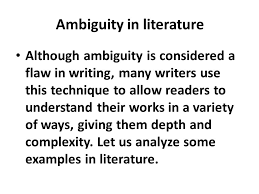Are you curious about the ambiguity technique in literature?
In this article, we’ll explore what it is and how it’s used to create depth and complexity in storytelling.
From classic literature to contemporary fiction and poetry, ambiguity leaves room for interpretation and sparks the imagination.
By examining its historical context and studying examples, we’ll analyze the effects it has on readers and uncover its role in enhancing narrative.
Get ready to dive into the fascinating world of the ambiguity technique in literature.
Historical Context of the Ambiguity Technique
You should consider the historical context when analyzing the ambiguity technique in literature. Understanding the time period in which a piece of literature was written allows you to grasp the societal and cultural influences that may have shaped the author’s intentions.
Ambiguity, as a technique, can be employed differently depending on the era in which it’s used. For example, during the Romantic period, ambiguity was often used to reflect the complex and contradictory nature of human emotions and desires. In contrast, during the Modernist era, ambiguity was employed to challenge traditional notions of meaning and truth.
Definition and Characteristics of Ambiguity in Literature
Consider the various ways ambiguity enhances the richness and depth of literary works.
When authors incorporate ambiguity into their writing, they create a sense of mystery and intrigue that captivates readers. By intentionally leaving certain details open to interpretation, they allow readers to actively engage with the text and form their own conclusions. This not only fosters a deeper level of connection between the reader and the work, but also encourages critical thinking and analysis.
Ambiguity also adds complexity to characters and plotlines, allowing for multiple layers of meaning and nuance. It challenges readers to explore different perspectives and encourages them to question their own assumptions and biases.
Ultimately, ambiguity in literature serves to stimulate intellectual curiosity and fosters a more immersive and rewarding reading experience.
Examples of Ambiguity Technique in Classic Literature
Classic literature is full of examples of ambiguity technique that leaves readers with multiple interpretations. As a reader, you may find yourself grappling with the subjective understanding of a character’s motives or the true meaning behind a symbol.
This ambiguity enriches the depth and complexity of the story, allowing for personal exploration and discussion.
Multiple Interpretations Possible
There’s no denying that ambiguity can lead to fascinating discussions and varied perspectives on a single piece of literature. When a story leaves room for interpretation, it opens up a world of possibilities for readers like you. Each person brings their own experiences, beliefs, and ideas to the table, which can result in a multitude of interpretations.
The beauty of ambiguity lies in the fact that there’s no right or wrong answer. It allows for personal connections to the text and encourages active engagement. As you delve into the depths of a story, you may find yourself discussing different themes, motives, and character traits with others who’ve formed their own unique opinions.
Embrace the ambiguity and enjoy the intellectual journey it takes you on.
Reader’s Subjective Understanding
As a reader, your subjective understanding of the ambiguity technique in literature can shape your interpretation and add depth to the story.
When an author uses ambiguity, they intentionally create situations or characters that can be interpreted in multiple ways. This technique leaves room for different perspectives and encourages readers to engage actively with the text.
Your own experiences, beliefs, and emotions influence how you perceive and make sense of the ambiguous elements. It allows you to explore different possibilities and consider alternative meanings.
This subjective understanding adds richness to the story, as it sparks curiosity and invites you to delve deeper into the narrative.
Enhances Depth and Complexity
When exploring examples of the ambiguity technique in literature, you’ll find that it enhances the depth and complexity of the narrative.
By leaving certain aspects of the story open to interpretation, authors invite readers to engage actively with the text, encouraging them to analyze and question what they’re reading.
This technique creates a sense of intrigue and captivates the reader’s attention, as they’re constantly trying to uncover the hidden meanings and truths within the story.
Ambiguity allows for multiple interpretations, allowing readers to form their own conclusions and adding a layer of richness to the narrative.
It challenges readers to think critically and forces them to consider different perspectives, ultimately leading to a more thought-provoking and intellectually stimulating reading experience.
Analyzing the Effects of Ambiguity on Reader Interpretation
You can easily see how ambiguity in a text can greatly influence your interpretation as a reader. When a text is ambiguous, it means that there’s more than one possible interpretation or meaning. This can lead to different readers having different understandings of the same piece of writing.
Ambiguity can be found in various literary devices such as symbolism, metaphor, or even in the choice of words. It forces you, as a reader, to engage in active interpretation and analysis. The lack of a clear answer or meaning can create a sense of curiosity and intrigue, as you search for clues and evidence to support your own understanding.
However, ambiguity can also be frustrating and confusing, especially when you’re trying to grasp the author’s intended message. It challenges you to think critically and consider multiple perspectives, ultimately enhancing your reading experience.
Ambiguity Technique in Contemporary Fiction and Poetry
If you’re unfamiliar with the ambiguity technique in contemporary fiction and poetry, it’s important to understand how it adds depth and complexity to the overall reading experience.
Ambiguity refers to the deliberate use of multiple possible meanings or interpretations in a literary work. It creates a sense of uncertainty and intrigue, forcing readers to engage more actively with the text.
By leaving certain elements open to interpretation, authors allow readers to bring their own perspectives and experiences into the reading process. This not only enriches the reading experience but also encourages critical thinking and analysis.
Ambiguity can be found in various aspects of a literary work, such as plot, character motivations, and symbolism. It challenges readers to question assumptions, explore different possibilities, and ultimately arrive at their own unique understanding of the text.
The Role of Ambiguity in Enhancing Narrative Complexity and Depth
Ambiguity plays a crucial role in enhancing the complexity and depth of narratives. By leaving certain aspects open to interpretation, ambiguity allows for narrative uncertainty and invites multiple interpretations from readers.
This not only adds layers of complexity to the story but also encourages deeper engagement and analysis, making the narrative more captivating and thought-provoking.
Narrative Uncertainty and Depth
Don’t be afraid to explore the narrative uncertainty and depth through the effective use of ambiguity in your writing. By embracing ambiguity, you invite readers into a world of intrigue and interpretation.
Ambiguity allows for multiple meanings and possibilities, creating a sense of mystery and engagement. It challenges readers to actively participate in the narrative, filling in the gaps with their own imaginations.
Through ambiguity, you can create complex characters with hidden motivations and conflicting emotions. You can weave intricate plotlines that keep readers guessing until the very end.
Ambiguity adds depth to your writing, allowing you to explore themes and ideas from different perspectives. So, embrace the uncertainty, embrace the depth, and let ambiguity be your ally in crafting compelling and thought-provoking narratives.
Multiple Interpretations and Complexity
You can explore the multiple interpretations and complexity of a narrative by delving into the intricate layers of its characters and plotlines.
When you analyze the various perspectives and motivations of the characters, you begin to uncover hidden depths and conflicting desires that add richness and complexity to the story.
Each character’s journey and interactions contribute to the overall narrative, weaving together a tapestry of interconnected themes and ideas.
The plotlines themselves can also be multi-layered, with subplots and parallel storylines that provide different angles and insights into the main narrative.
By examining these intricate layers, you can discover the nuances and subtleties that make a story truly compelling and thought-provoking.
The exploration of multiple interpretations and complexity allows for a deeper understanding and appreciation of the narrative’s intricacies.
Ambiguity’s Impact on Storytelling
Exploring the various perspectives and motivations of characters adds layers of complexity and depth to the narrative, immersing readers in a rich tapestry of interconnected themes and ideas.
One way this is achieved is through the use of ambiguity in storytelling. Ambiguity allows for multiple interpretations and creates a sense of intrigue and uncertainty. It challenges readers to actively engage with the text, searching for clues and making their own conclusions.
By intentionally leaving certain details open to interpretation, authors invite readers to participate in the construction of meaning. This active participation not only enhances the reading experience, but also encourages critical thinking and deepens our understanding of the story.
Ambiguity can be found in various literary elements such as character motivations, plot twists, and symbolic imagery, further enriching the narrative and captivating readers.
Conclusion
In conclusion, the ambiguity technique in literature serves as a powerful tool for authors to engage readers and encourage them to actively interpret and analyze the text.
Whether used in classic literature or contemporary fiction and poetry, ambiguity adds complexity and depth to narratives. By leaving room for multiple interpretations, ambiguity allows readers to explore different meanings and perspectives, making the reading experience more thought-provoking and enriching.


